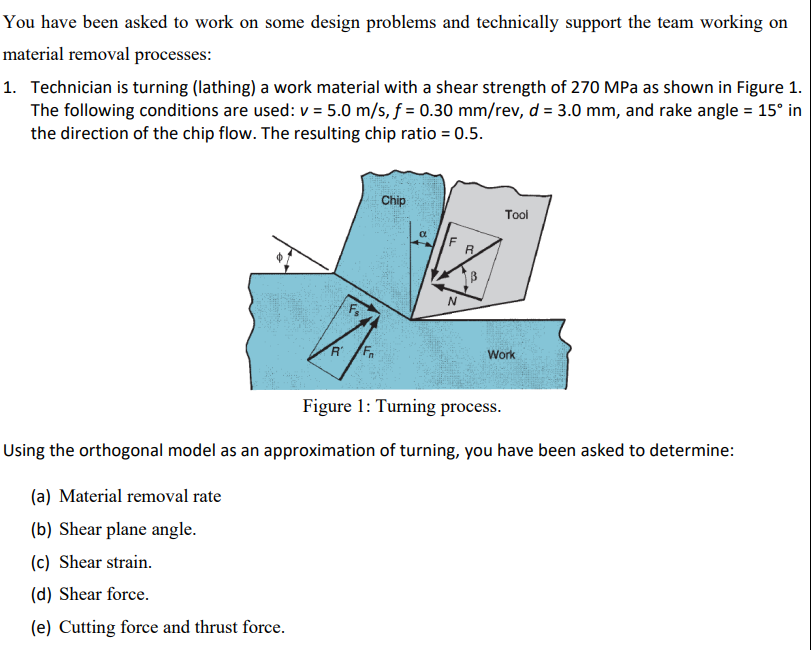You have been asked to work on some design problems and technically support the team working on material removal processes: 1. Technician is turning (lathing) a work material with a shear strength of 270 MPa as shown in Figure 1. The following conditions are used: v = 5.0 m/s, f = 0.30 mm/rev, d = 3.0 mm, and rake angle = 15° in the direction of the chip flow. The resulting chip ratio = 0.5. Chip Tool RF Work Figure 1: Turning process. Using the orthogonal model as an approximation of turning, you have been asked to determine: (a) Material removal rate (b) Shear plane angle. (c) Shear strain.
You have been asked to work on some design problems and technically support the team working on material removal processes: 1. Technician is turning (lathing) a work material with a shear strength of 270 MPa as shown in Figure 1. The following conditions are used: v = 5.0 m/s, f = 0.30 mm/rev, d = 3.0 mm, and rake angle = 15° in the direction of the chip flow. The resulting chip ratio = 0.5. Chip Tool RF Work Figure 1: Turning process. Using the orthogonal model as an approximation of turning, you have been asked to determine: (a) Material removal rate (b) Shear plane angle. (c) Shear strain.
Elements Of Electromagnetics
7th Edition
ISBN:9780190698614
Author:Sadiku, Matthew N. O.
Publisher:Sadiku, Matthew N. O.
ChapterMA: Math Assessment
Section: Chapter Questions
Problem 1.1MA
Related questions
Question

Transcribed Image Text:You have been asked to work on some design problems and technically support the team working on
material removal processes:
1. Technician is turning (lathing) a work material with a shear strength of 270 MPa as shown in Figure 1.
The following conditions are used: v = 5.0 m/s, f = 0.30 mm/rev, d = 3.0 mm, and rake angle = 15° in
the direction of the chip flow. The resulting chip ratio = 0.5.
Chip
Tool
R.
RF.
Work
Figure 1: Turning process.
Using the orthogonal model as an approximation of turning, you have been asked to determine:
(a) Material removal rate
(b) Shear plane angle.
(c) Shear strain.
(d) Shear force.
(e) Cutting force and thrust force.
Expert Solution
This question has been solved!
Explore an expertly crafted, step-by-step solution for a thorough understanding of key concepts.
Step by step
Solved in 3 steps

Knowledge Booster
Learn more about
Need a deep-dive on the concept behind this application? Look no further. Learn more about this topic, mechanical-engineering and related others by exploring similar questions and additional content below.Recommended textbooks for you

Elements Of Electromagnetics
Mechanical Engineering
ISBN:
9780190698614
Author:
Sadiku, Matthew N. O.
Publisher:
Oxford University Press

Mechanics of Materials (10th Edition)
Mechanical Engineering
ISBN:
9780134319650
Author:
Russell C. Hibbeler
Publisher:
PEARSON

Thermodynamics: An Engineering Approach
Mechanical Engineering
ISBN:
9781259822674
Author:
Yunus A. Cengel Dr., Michael A. Boles
Publisher:
McGraw-Hill Education

Elements Of Electromagnetics
Mechanical Engineering
ISBN:
9780190698614
Author:
Sadiku, Matthew N. O.
Publisher:
Oxford University Press

Mechanics of Materials (10th Edition)
Mechanical Engineering
ISBN:
9780134319650
Author:
Russell C. Hibbeler
Publisher:
PEARSON

Thermodynamics: An Engineering Approach
Mechanical Engineering
ISBN:
9781259822674
Author:
Yunus A. Cengel Dr., Michael A. Boles
Publisher:
McGraw-Hill Education

Control Systems Engineering
Mechanical Engineering
ISBN:
9781118170519
Author:
Norman S. Nise
Publisher:
WILEY

Mechanics of Materials (MindTap Course List)
Mechanical Engineering
ISBN:
9781337093347
Author:
Barry J. Goodno, James M. Gere
Publisher:
Cengage Learning

Engineering Mechanics: Statics
Mechanical Engineering
ISBN:
9781118807330
Author:
James L. Meriam, L. G. Kraige, J. N. Bolton
Publisher:
WILEY